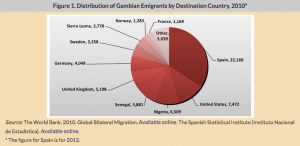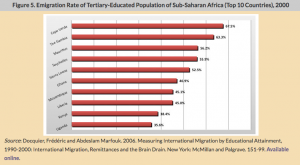C. O mar Kebbeh, 2013
Lien vers le document original [Fr] [En]
Modern Migration Trends, Economic Downturn
By the end of the 1980s, rural-to-urban migration and especially emigration to Europe and North America had become common coping strategies — and enduring ones. Faced with low remuneration, lack of job security, and poor management of the health-care system, many Gambians, especially those working or aspiring to work in the medical field, began moving abroad for better opportunities.
The 1994 military coup — during which current president Yahya Jammeh took power — caused an increase in asylum seekers, and so prompted the United Kingdom and other European countries to require Gambians to obtain a visa before travelling. However, despite the tightening of immigration policies and enforcement, large numbers of young Gambian men continued to migrate to Europe, legally and illegally, in search of better opportunities.
Emigration Trends

Migration and Development Considerations

The Gambian Diaspora
There are currently dozens of diaspora associations in the United States, Spain, and other major destination countries for Gambian migrants. Among the most prominent are The Gambian American Association of greater Washington DC, Atlanta Gambia Emergency Relief Association (Agera), Seattle Gambian Association, Gambia United Society (United Kingdom), and Gambians in Finland Association. The main goal of these associations is addressing the welfare of Gambians in their respective communities.
The Gambian government has only very recently begun reaching out to and recognizing the contributions of its citizens abroad. In 2012, the mandate of the Ministry of Foreign Affairs, International Cooperation and Gambians Abroad was expanded to take on directly all diaspora affairs. Previously, there was no centralized, official agency dealing with these issues.
Migration Policies
At the time of the writing of this article, The Gambia did not have a comprehensive migration policy but instead dealt with issues such as illegal immigration on a case-by-case basis. Although in 2006 the governments of The Gambia and Spain signed an immigration agreement aimed to control illegal immigration, many argue that the agreement did not go far enough as more young Gambians continued their attempt to enter Spain illegally.
For example, in 2008 a Spanish plane deporting more than 100 unauthorized migrants to The Gambia was forced to return to Spain with all passengers still on board, after Gambian authorities refused to let the deportees disembark. In addition, a pact aimed at combating illegal migration through capacity building of the Gambian immigration personnel was signed between the Gambia and Italy in 2013.
The Gambia is a signatory of the 1951 Convention Relating to the Status of Refugees (1951 Convention) and its 1967 Protocol, but maintains reservations on its clauses providing exemptions for refugees from exceptional and provisional measures, the right to work, labor protection, social security, and administrative assistance.
The Gambia also signed the 1969 Convention Governing the Specific Aspects of Refugee Problems in Africa. Recognizing The Gambia as a destination for West African refugees, deputies of the Gambian National Assembly in 2008 unanimously passed a Refugee Bill, which established The Gambia Commission for Refugees, a body that is tasked with coordinating and managing policy matters relating to refugee affairs in the country.
